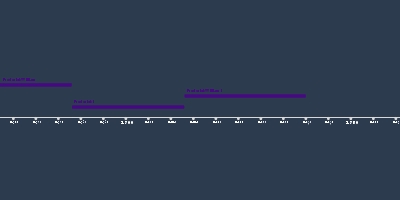Romanticism (jan 1, 1790 – jan 1, 1840)
Description:
Contrary to the emphasis on rationality and restraint during the Enlightenment and style of classicism, Romanticism pursued emotional exuberance, unrestrained imagination, and spontaneity in art and life. Romantics valued intuition and nostalgia for the past, sought inspiration of religious ecstasy, delved into the supernatural and turned inward, looking towards the power of love and desire, hatred and despair, etc., all contrary to Enlightenment thinkers. The movement supported a range of emotions and political views.The Romantics were far more interested in nature than their predecessors, and saw modern industry as an encroachment on it. History became an obsession and allowed them to perceive the universe as more organic and dynamic. Romantics often lived lives of emotional intensity with bohemian lifestyles and a rejection of a refined society. This style found its distinctive voice in poetry, and most of the first great poets were English.
William Wordsworth, who was deeply influenced by Rousseau and the early French Revolution, lived with (along with his sister) Samuel Taylor Coleridge. In 1798 they both published their Lyrical Ballads, which favored the language of ordinary speech and endowed simple subjects with the loftiest majesty. Wordsworth believed all things sacred and loved nature.
Literature and lifestyle merged within a group of bohemians who lived for poetic experience that included Percy Bysshe Shelly, Lord Byron, and Mary Shelley, who wrote Frankenstein.
Among the likes of fellow romantics like Alphonse de Lamartine and Amandine-Aurore-Lucile Dudevant under the pseudonym George Sand, Victor Hugo achieved renown for his novels like The Hunchback of Notre Dame that exemplified the Romantic fascination with fantastic characters, exotic historical settings, and extreme emotions. Hugo renounced his early conservatism in favor of liberalism, working the opposite as Wordsworth’s political evolution.
In central and eastern Europe, literary Romanticism and nationalism often worked together. Scholars studied their people’s histories, cultures, and unique greatness. The brothers Grimm brought German folktales from oblivion. In the Slavic lands, spoken peasant languages were converted into modern written languages, which built regional national identities.
Eugene Delacroix was one of Romanticism’s greatest artists. He painted dramatic, colorful scenes that stirred the emotions. He was fascinated with remote and exotic subjects. German painter Casper David Friedrich painted somber landscapes that captured the divine presence in natural forces. English painter M.W. Turner painted nature’s power and terror while John Constable depicted gentle landscapes.
Musicians, like Chopin and Franz Liszt, transformed the small classical orchestra and increased its emotional intensity. This gave musicians greater prestige and publicity. Beethoven used contrasting themes and tones to produce dramatic conflict and inspiring resolutions.
Added to timeline:
Date:
jan 1, 1790
jan 1, 1840
~ 50 years
